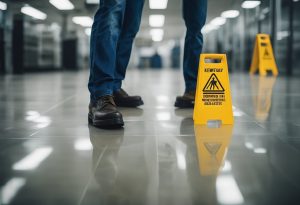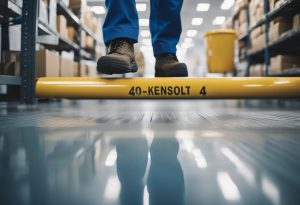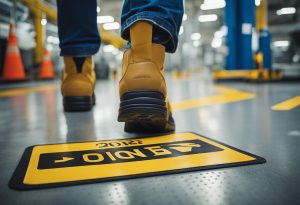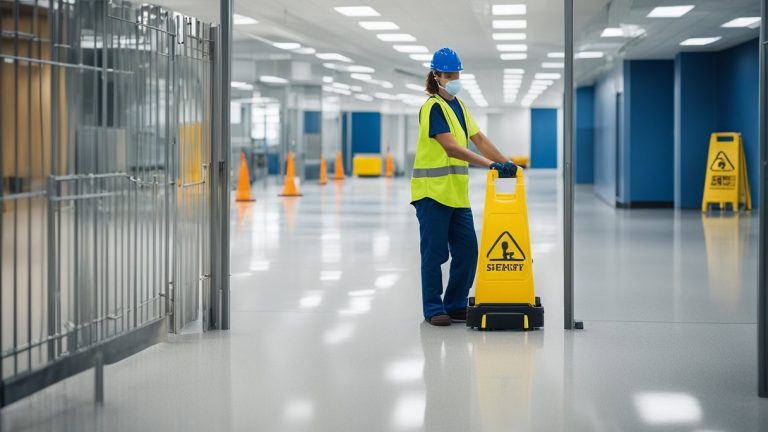Slip and fall accidents are a common occurrence in Kentucky workplaces, and they can lead to serious injuries. These accidents can happen in any work environment, from offices to construction sites. Preventing slip and fall accidents is essential to ensure the safety of employees and reduce the risk of costly lawsuits for employers.
Employers and employees alike can take steps to prevent slip and fall accidents in the workplace. This includes maintaining a clean and organized workspace, promptly cleaning up spills, and providing appropriate footwear for employees. Additionally, employers should conduct regular safety inspections to identify and address potential hazards. By implementing preventive measures and safety protocols, employers can create a safer work environment for their employees.
Understanding Slip and Fall Accidents

Slip and fall accidents are a common occurrence in workplaces, and they can lead to serious injuries. These accidents can happen to anyone, regardless of their age or occupation. Slip-and-fall accidents are often preventable and involve the negligence of a property owner, governmental entity, or workplace.
According to a study conducted by the Bureau of Labor Statistics (BLS), slip and fall accidents are one of the leading causes of workplace injuries. In fact, slip and fall accidents account for over 20% of all workplace injuries. These accidents can result in serious injuries, such as broken bones, head injuries, and spinal cord injuries.
There are many factors that can contribute to slip and fall accidents in the workplace. Some of the most common causes of slip and fall accidents include wet or greasy floors, spills, loose debris, and uneven surfaces. Employers have a responsibility to maintain a safe work environment for their employees, and failure to do so can result in serious injuries.
To prevent slip and fall accidents, it is important to identify potential hazards in the workplace. This can be done by conducting regular inspections of the workplace and addressing any hazards that are identified. Employers should also provide proper training to their employees on how to identify and avoid slip and fall hazards.
In conclusion, slip and fall accidents are a serious issue in the workplace, and they can lead to serious injuries. Employers have a responsibility to maintain a safe work environment for their employees, and failure to do so can result in serious consequences. By identifying potential hazards and providing proper training to employees, employers can help prevent slip and fall accidents and ensure the safety of their workforce.
Identifying Potential Hazards

Preventing slip and fall accidents in Kentucky workplaces requires identifying potential hazards. There are two main categories of hazards that employers should be aware of: environmental conditions and workplace conditions.
Environmental Conditions
Environmental conditions refer to external factors that can contribute to slip and fall accidents. These include rain, snow, mud, ice, and poor lighting. Employers should regularly inspect the exterior of their workplace to ensure that there are no hazards that could cause an accident.
Parking lots and sidewalks are common areas where slip and fall accidents occur. Employers should ensure that these areas are well-lit and free of debris, gravel, leaves, pine needles, and other obstacles. Snow and ice should be promptly removed, and salt or sand should be applied to prevent slippery conditions.
Workplace Conditions
Workplace conditions refer to internal factors that can contribute to slip and fall accidents. These include wet or slippery floors, loose floor tiles, changes in elevation, and cluttered walkways. Employers should ensure that all areas of the workplace are well-lit and that there are no tripping hazards such as cords or cables.
Tools and equipment should be stored properly when not in use, and spills or debris should be promptly cleaned up. Sloped walking surfaces and unmarked steps should be clearly indicated with signage or paint.
By regularly inspecting the workplace for potential hazards, employers can take proactive steps to prevent slip and fall accidents.
Prevention and Safety Measures

Preventing slip and fall accidents in the workplace requires a combination of proper training, equipment, and maintenance. Here are some key measures that can be taken to reduce the risk of slip and fall accidents in Kentucky workplaces.
Workplace Training
One of the most effective ways to prevent slip and fall accidents is to provide proper training to employees. This training should cover topics such as good housekeeping practices, proper footwear, and the safe use of ladders, platforms, and scaffolds. Employees should also be trained on how to identify and report potential hazards, such as wet or slippery surfaces, damaged flooring or stair treads, and missing or loose handrails.
Proper Equipment and Maintenance
Another important factor in preventing slip and fall accidents is ensuring that the workplace is equipped with the proper equipment and that it is regularly maintained. This includes slip-resistant shoes, handrails, and other safety equipment. Employers should also ensure that walking surfaces are free from hazards and are well-maintained, including regular cleaning and repairs. Regular maintenance of equipment and flooring surfaces is also important to prevent accidents.
In addition, employers should ensure compliance with OSHA regulations regarding fall protection and working surfaces. This includes providing fall protection equipment at elevations of four feet or more in general industry workplaces, and ensuring that walking-working surfaces are free from hazards that could cause slips, trips, or falls.
By following these prevention and safety measures, employers can reduce the risk of slip and fall accidents in Kentucky workplaces.
Legal Aspects of Slip and Fall Accidents
Slip and fall accidents can have serious legal implications for both the employee and the employer. In Kentucky, employers are required to provide a safe working environment for their employees. If an employee is injured due to a slip and fall accident, they may be eligible for compensation for their injuries.
The responsibility for slip and fall accidents can fall on both the employee and the employer. The employee has a responsibility to take reasonable care to avoid accidents, while the employer has a responsibility to identify and mitigate potential hazards. If the property owner is found to be responsible, they may be held liable for damages.
If an employee is injured due to a slip and fall accident, they should seek medical attention immediately. They should also report the accident to their employer and document the incident. If the employee wishes to pursue a legal claim, they should contact a personal injury attorney who specializes in slip and fall accidents. Many personal injury attorneys offer free consultations to discuss the details of the case.
In Kentucky, slip and fall accidents are subject to negligence laws. This means that the employee must prove that the property owner was negligent in maintaining the property. The employee must also prove that the negligence was the direct cause of their injuries.
Property owners have a responsibility to maintain their property and keep it safe for visitors. This includes maintaining entrances and exits, ensuring proper friction on walking surfaces, and complying with workplace safety regulations. Failure to do so can result in lost productivity, personal injury cases, and even wrongful death lawsuits.
According to the Centers for Disease Control, slip and fall accidents are a leading cause of severe injuries and death in the United States. It is important for employers and property owners to take preventative measures to reduce the risk of slip and fall accidents.
Conclusion
Preventing slip and fall accidents in Kentucky workplaces is crucial for the safety of employees and employers alike. By implementing simple measures, such as keeping aisles and walkways clear of clutter and debris, using non-slip flooring and appropriate footwear, and providing proper training on ladder safety, employers can significantly reduce workplace injuries.
It is important to note that slip and fall accidents can happen to both men and women, and can occur in various workplace settings, including offices, factories, and construction sites. Dust and debris on tile or concrete floors can increase the risk of slip and fall accidents, making it important to regularly clean and maintain these surfaces.
Employers should also ensure that employees are aware of the risks associated with inappropriate footwear, such as high heels or shoes with worn-out soles. Providing slip-resistant shoes can significantly reduce the risk of slip and fall accidents.
By taking a proactive approach to workplace safety and implementing preventative measures, employers can help prevent slip and fall accidents and reduce the risk of workplace injuries.

